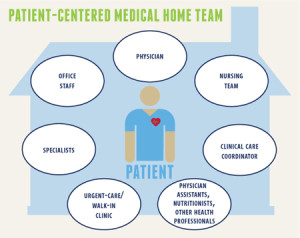 It’s called “primary” care for a reason: it’s first and foremost important in the health care services a person can use.
It’s called “primary” care for a reason: it’s first and foremost important in the health care services a person can use.
In its report, Primary care: our first line of defense, The Commonwealth Fund explains why primary care is crucial to one’s individual health, and how primary care is morphing into medical teams and patient-centered medical homes.
And that’s a good thing for you and me, the Fund says. That’s because people in the U.S. who have a primary care doctor have 33% lower health costs and 19% lower risk of dying than people who see only a specialist (Source: Barbara Starfield et. al. in Contribution of Primary care to Health Systems and Health).
Without primary care providers, we’d end up in the emergency room to treat sore throats, manage chronic health conditions like diabetes, and get flu shots.
That adds up to inconvenience, exposure to risks like hospital-borne infections (THINK: MRSA), and higher costs for patients, health insurance plans, and society-at-large.
Primary care today, and going forward, is moving from a focus on doctors alone to doctors-plus-a-health-team. That health team is pictured in the graphic: the health team can include many hands that help patients, such as nurse practitioners, physician assistants, diabetes educators, health coaches, urgent care and retail health clinics, worksite clinics, and specialists, among other care providers. This concept of the medical home extends care beyond the doctor – freeing her up to her so-called highest and best use, which means for those patients who truly need to see the doctor face-to-face.
Members of the extended care team provide continuity of care for patients in-between those high-touch physician visits – like following up with patients to make sure they are taking prescribed medications, or checking to make sure someone with diabetes knows how to administer insulin properly.
The Fund points out that the Affordable Care Act includes funding to expand primary care and provide more funding to expand the number of primary care doctors as well as physician extenders like nurse practitioners and physician assistants.
A key aspect of the medical home is the electronic health record (EHR), which records patients’ numbers and histories over time. The EHR helps the various providers in the medical home keep track of patients’ health as many providers are caring for the patient – whom the medical home puts at the center, as the graphic illustrates.
Health Populi’s Hot Points: Health reform — whether you term it the Affordable Care Act or Obamacare — has a focus on primary care access for health citizens and the growing role of the medical home and accountable care. There is a shortage of primary care doctors in the U.S., which the complementary providers such as nurse practitioners, physicians assistants, health coaches and others can help address.
I talked about this opportunity in my paper for California HealthCare Foundation, Primary Care, Everywhere. Health care delivered in the community, closer to patients and in more convenient ways (whether in terms of hours, geographic access, cultural preferences or a combination of all three aspects), will improve peoples’ health and better manage costs. Using specialists and emergency rooms as the first point of contact in the health system is wasteful, risky, and very Old School. The medical home and team-based care are needed innovations for a 21st century health system in America.




 Interviewed live on BNN Bloomberg (Canada) on the market for GLP-1 drugs for weight loss and their impact on both the health care system and consumer goods and services -- notably, food, nutrition, retail health, gyms, and other sectors.
Interviewed live on BNN Bloomberg (Canada) on the market for GLP-1 drugs for weight loss and their impact on both the health care system and consumer goods and services -- notably, food, nutrition, retail health, gyms, and other sectors. Thank you, Feedspot, for
Thank you, Feedspot, for  As you may know, I have been splitting work- and living-time between the U.S. and the E.U., most recently living in and working from Brussels. In the month of September 2024, I'll be splitting time between London and other parts of the U.K., and Italy where I'll be working with clients on consumer health, self-care and home care focused on food-as-medicine, digital health, business and scenario planning for the future...
As you may know, I have been splitting work- and living-time between the U.S. and the E.U., most recently living in and working from Brussels. In the month of September 2024, I'll be splitting time between London and other parts of the U.K., and Italy where I'll be working with clients on consumer health, self-care and home care focused on food-as-medicine, digital health, business and scenario planning for the future...